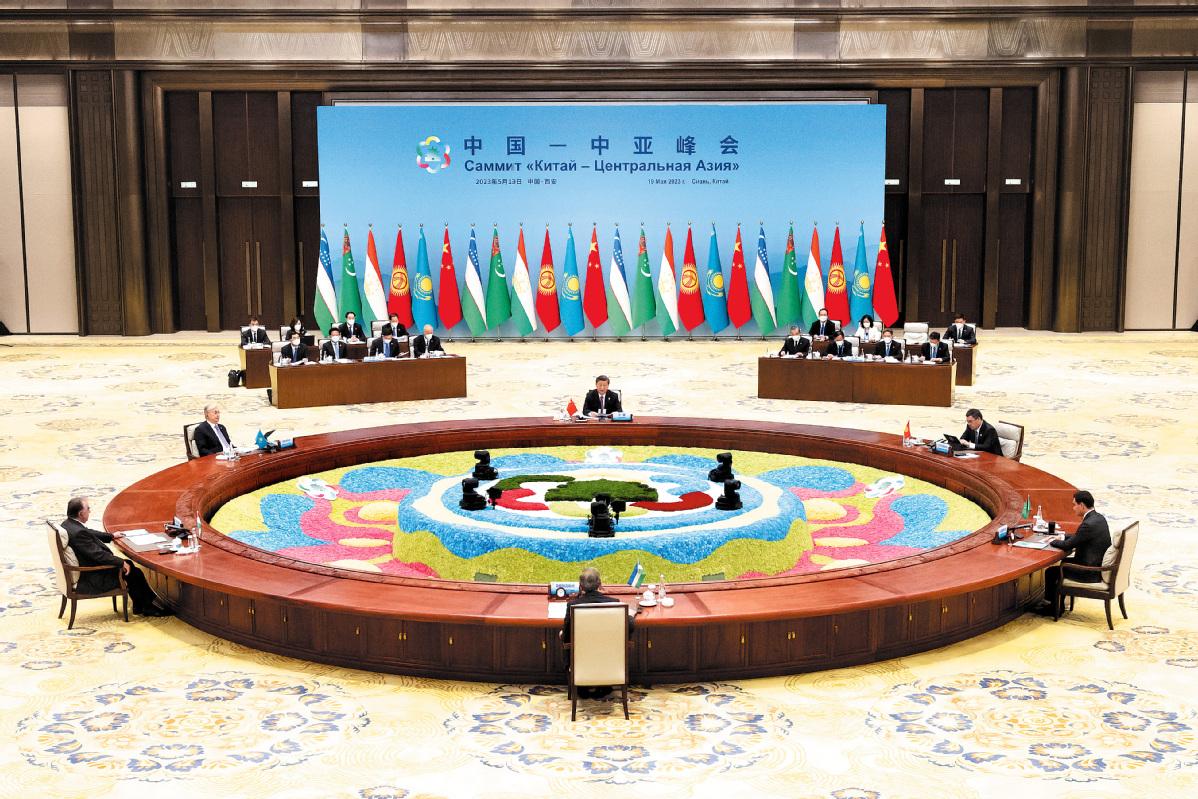
President Xi Jinping chairs the first China-Central Asia Summit and delivers a keynote speech in Xi'an, Shaanxi province, on May 19. [Photo by Ding Haitao/Xinhua]
By William Jones
The China-Central Asia Summit held on Thursday and Friday in Xi'an, Shaanxi province, an event of striking symbolism, has taken the development of the China-proposed Belt and Road Initiative to a higher stage.
The city of Xi'an, which was the capital in the Tang Dynasty (618-907), was also China's bridge to the West via the ancient Silk Road. The city has now become a major transportation and service hub for the BRI, which marks its 10th anniversary this year.
President Xi Jinping held a welcoming ceremony teeming with elements of the Tang Dynasty, and during the banquet afterward, guests were served Tang dishes and Shaanxi specialties. There were also major cultural events around the summit, with performers and dancers in Tang Dynasty garb and singers and acrobats from many Central Asian countries performing, which underscored the cultural exchanges in this new level of unity.
During the summit, the leaders formed a mechanism for meetings among the heads of state of China and Central Asian countries and established a permanent secretariat for the mechanism, underlining the permanence of the relationship. The leaders decided that the next summit will be hosted by Kazakhstan in 2025.
A similar mechanism will also be established at the ministerial level. Furthermore, China and the five Central Asian nations will set up a joint business council to encourage greater investment in each other's economies.
The leaders signed seven bilateral and multilateral documents, including the Xi'an Declaration of the China-Central Asia Summit and the China-Central Asia Summit Outcome List. They also signed more than 100 cooperation agreements in various fields.
The Xi'an Declaration underlined the importance of the Belt and Road Initiative and promised greater coordination between the BRI and the individual development programs of the Central Asian countries.
China promised to increase trade along the many lines of transportation between China and Central Asia. In the declaration, the parties emphasized that "Central Asia should consolidate its important position as the transportation hub" of the Eurasian region, accelerating the construction of China-Central Asia transportation corridors and further developing China-Central Asia-South Asia and China-Central Asia-Middle East ties, as well as China-Central Asia-Europe relations.
In his speech to the summit on Friday, President Xi said that China would modernize the existing border ports at a faster pace, open a new border port in the Xinjiang Uygur autonomous region, promote the air transportation market, and build a regional logistics network.
In his comments, Xi laid out four important principles that should guide the countries in their collaborative efforts. The first is mutual assistance on core issues such as maintaining the sovereignty and independence of each nation. The second is working toward common development. The third principle is assuring universal security and guarding against the three dangers of separatism, terrorism and extremism. The fourth is assuring everlasting friendship and, in that spirit, helping to realize the China-proposed Global Civilization Initiative.
Looking broadly at the Eurasian region today, one sees the tremendous instability created by the West's sanctions on Russia and its continual provocations on the all-important Taiwan question.
The newly consolidated relationship between China and the Central Asian countries represents an island of harmony in a sea of troubles.
The Xi'an Declaration also calls for the right of each country to pursue its own development path, a principle that the majority of the developing Global South fully supports. In addition, China and the five Central Asian nations resolved to guard against "color revolutions". In that regard, China promised greater assistance and cooperation with the Central Asian countries in the area of law enforcement and security in the region.
The Central Asian countries also expressed support for the Global Development Initiative, the Global Security Initiative and the Global Civilization Initiative and will work toward their implementation.
In addition, China will work with the Central Asian countries in the area of energy and food production. In his speech, President Xi emphasized that China will work with the Central Asian countries to cooperate in such areas as using saline and alkali land and improving water-saving irrigation, building a joint laboratory on agriculture in arid lands, and tackling the ecological crisis of the Aral Sea.
Xi said that China supports establishing high-tech companies and IT industrial parks in Central Asia and welcomes Central Asian countries to participate in special cooperation programs under the Belt and Road Initiative.
What began 10 years ago with the Silk Road Economic Belt, which along with the 21st Century Maritime Silk Road became the Belt and Road Initiative, was consolidated at last year's virtual China-Central Asia Summit. It has now been placed on the fast track and will be an important institutional force for stability in the region, as well as a model for how countries can work together for mutual benefit.
While the recent G7 Summit in Hiroshima, Japan, worked toward dividing the world into blocs, China is working to bring countries together around the question of their own development.
The author is a former White House correspondent for EIR News Service and a nonresident fellow at Renmin University's Chongyang Institute for Financial Studies.

 中文
中文



